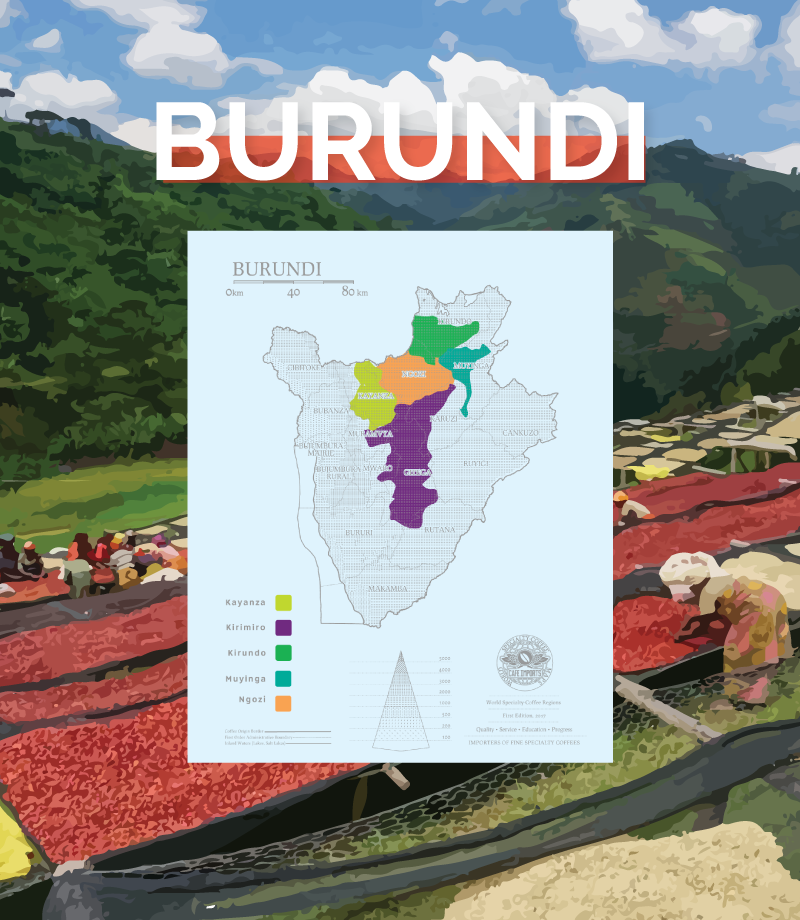History and Culture of Coffee beans in Burundi what is the mode of transportation and sales of coffee agricultural production and development
Coffee was introduced to Burundi by Belgian colonists in the 1920s, when it was a forced crop: farmers were required to plant a government-mandated number of coffee trees-of course, they received little for their labor or land. Once the country gained independence in the 1960s, the coffee industry (and others) was privatized, depriving control from the government, unless research or price stability and market intervention were necessary. However the cruel history of coffee under Belgian rule left many people with a bitter taste and crops fell out of favor: as a result the quality declined significantly and coffee plants were completely torn or ignored. During and immediately after the civil war in the early 1990s, production fell sharply and the national economy was almost completely destroyed.

In the early 2000s, coffee became a tool for reviving the agricultural sector and increasing foreign exchange: inspired in large part by its impact in rebuilding the economy of neighbouring Rwanda after the Rwanda genocide, investors began to focus on Burundi to recreate this success story. There has been a combination of public and private coffee operations, and with the resumption of cleaning stations, so has producers' interest in growing coffee.

The average farm area in Burundi is 1 hectare, 8-1 hectare, and most producers use the land to grow food crops in addition to coffee. Because of the very small size of the farm, producers usually ship the harvested cherries in the form of cherries to a central cleaning station or CPU (coffee processing unit), including semi-private, semi-government-operated receiving and receiving networks run by Sogestals. A processing station that may serve hundreds or even more than 1000 manufacturers in one season.
Producers pay by weight of coffee, and their batches are mixed when delivered at the washing station, which means that traceability and transparency are limited: it is impossible to determine which manufacturer's coffee is in which bag in the batch, so there is no way to pay a higher price to individual producers for their coffee. In fact paying higher prices to some producers than others is likely to lead to political and social unrest within communities and among growers. Therefore, it is important to work with companies and entities that are known to pay higher overall prices. Since Burundi is a landlocked country, coffee is usually purchased by La Bodega FOT (free by truck); coffee needs to be trucked to Tanzania for shipping. Producers pay by weight of coffee, and their batches are mixed when delivered at the washing station, which means that traceability and transparency are limited: it is impossible to determine which manufacturer's coffee is in which bag in the batch, so there is no way to pay a higher price to individual producers for their coffee. In fact paying higher prices to some producers than others is likely to lead to political and social unrest within communities and among growers. Therefore, it is important to work with companies and entities that are known to pay higher overall prices. Since Burundi is a landlocked country, coffee is usually purchased by La Bodega FOT (free by truck); coffee needs to be trucked to Tanzania for shipping.
Important Notice :
前街咖啡 FrontStreet Coffee has moved to new addredd:
FrontStreet Coffee Address: 315,Donghua East Road,GuangZhou
Tel:020 38364473
- Prev

Flavor and taste characteristics of Rwandan coffee beans and its historical development what is the "potato defect"
The history of coffee bean production in Rwanda | what is the defect of potatoes? if a coffee bean is described as bright acidity, such as cranberries or grapefruit, flowers and sweet herbs such as chamomile, and sweet nuts such as almonds or macadamia nuts. Would you like to try this kind of coffee? So the editor will walk into Rwanda with you today. Let's get to know each other first.
- Next

The influence of delicious Central and South American Coffee beans on World Coffee what do you mean by premium coffee beans?
There are many coffee producing areas in Central America, which show their elegant demeanor in all the major coffee competitions. As an important part of boutique coffee, what is his influence on the world boutique coffee? What are his unique features worth imitating and learning? Next, let the editor study with you. The first point is that it has greatly increased the market price of coffee beans.
Related
- Detailed explanation of Jadeite planting Land in Panamanian Jadeite Manor introduction to the grading system of Jadeite competitive bidding, Red bid, Green bid and Rose Summer
- Story of Coffee planting in Brenka region of Costa Rica Stonehenge Manor anaerobic heavy honey treatment of flavor mouth
- What's on the barrel of Blue Mountain Coffee beans?
- Can American coffee also pull flowers? How to use hot American style to pull out a good-looking pattern?
- Can you make a cold extract with coffee beans? What is the right proportion for cold-extracted coffee formula?
- Indonesian PWN Gold Mandrine Coffee Origin Features Flavor How to Chong? Mandolin coffee is American.
- A brief introduction to the flavor characteristics of Brazilian yellow bourbon coffee beans
- What is the effect of different water quality on the flavor of cold-extracted coffee? What kind of water is best for brewing coffee?
- Why do you think of Rose Summer whenever you mention Panamanian coffee?
- Introduction to the characteristics of authentic blue mountain coffee bean producing areas? What is the CIB Coffee Authority in Jamaica?

